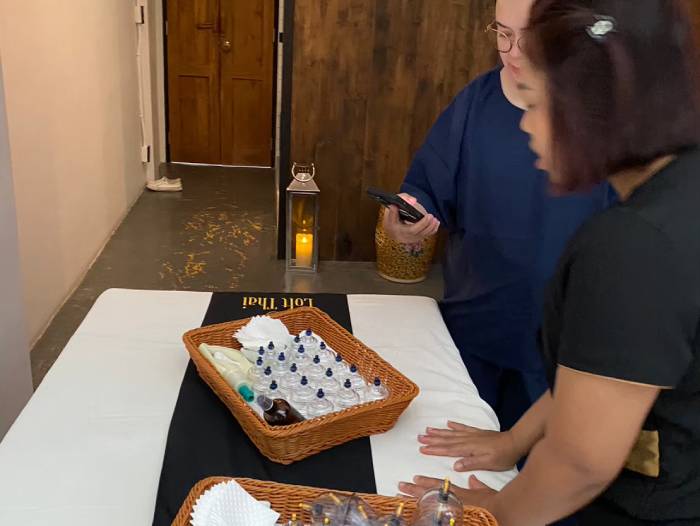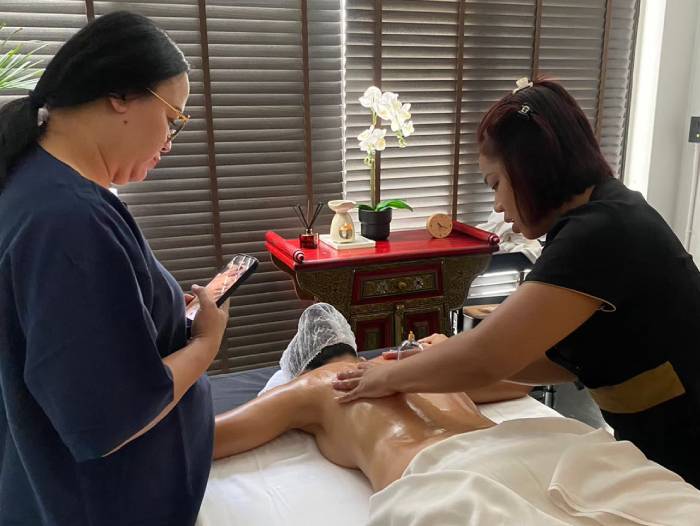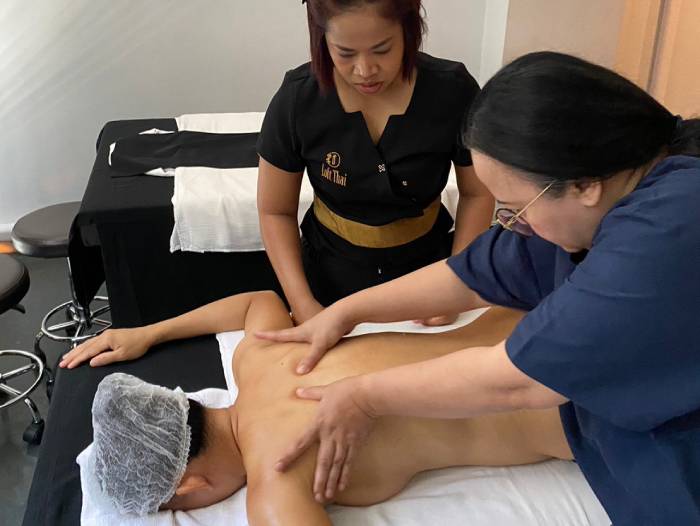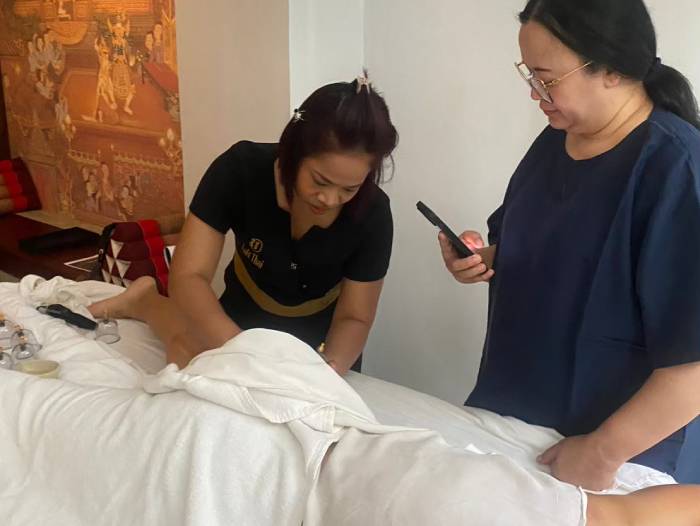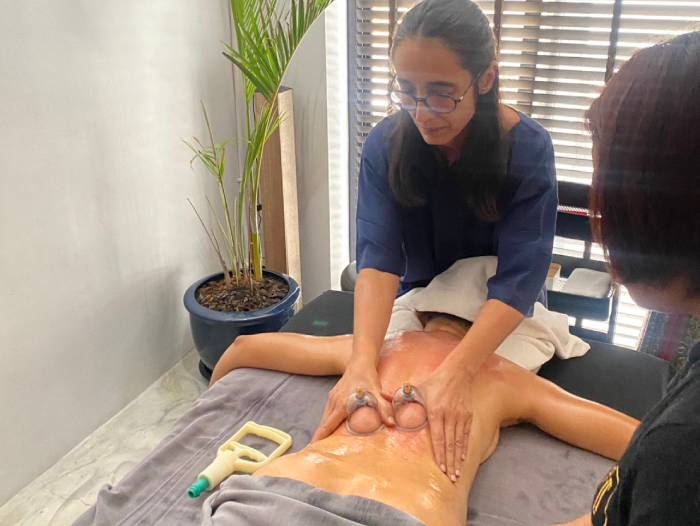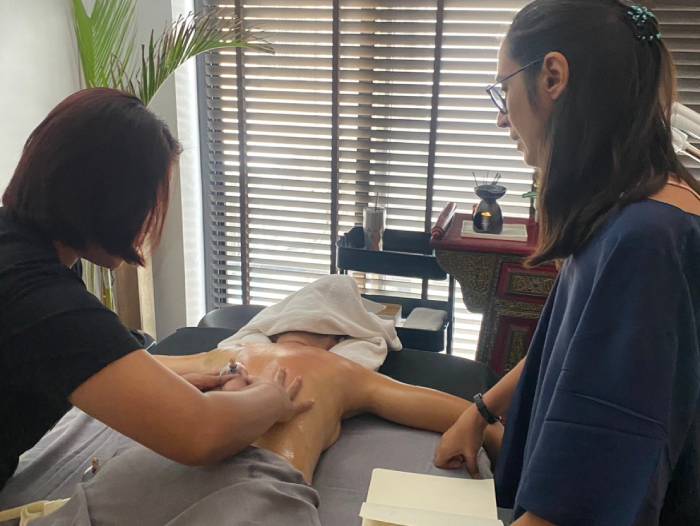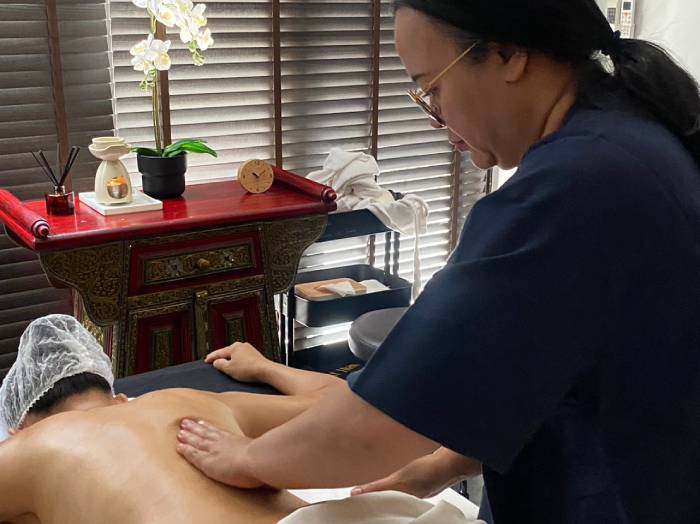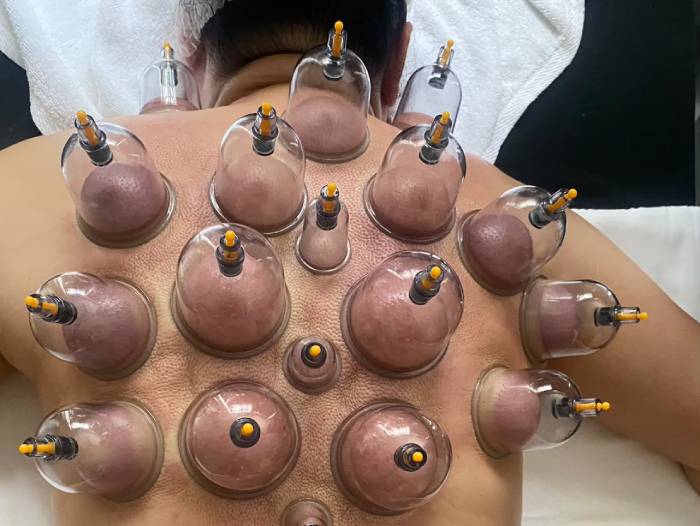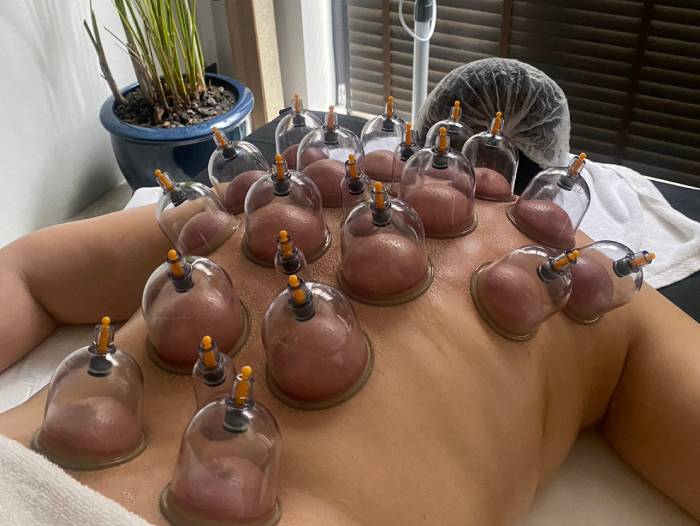Embrace the Power of Negative Pressure Healing
The Cupping Therapy Massage Course at our Bangkok-based massage school introduces students to one of the oldest and most respected therapeutic practices in traditional medicine—cupping. Known across civilizations and cultures, cupping therapy has long been celebrated for its ability to relieve deep muscle tension, boost circulation, detoxify the body, and restore the body’s natural flow of energy. Today, it is increasingly sought after in both clinical and spa settings, making it a valuable skill for massage therapists, wellness practitioners, and health-conscious individuals seeking to deepen their healing expertise.
This comprehensive course combines traditional principles with modern techniques, equipping students with the theoretical knowledge and hands-on skills needed to apply cupping therapy safely, effectively, and professionally. Through guided practice, students will explore both dry and moving cupping, learn to work with glass, silicone, and vacuum cups, and gain a deep understanding of how this powerful method can complement massage therapy for results-oriented bodywork.
Whether you are looking to add cupping therapy to your existing massage practice or begin a new chapter in holistic healing, this course offers a transformative and culturally rich learning experience in the heart of Thailand.
Bangkok and Sukhumvit – A Modern Sanctuary for Ancient Healing
Bangkok is a city where the past and present dance together. Known not only for its vibrant street life and modern infrastructure but also for its deep roots in traditional healing arts, Bangkok has become a world-renowned destination for those who seek high-quality massage and wellness education. The Thai capital is home to hundreds of spas, healing centers, and massage schools, each contributing to the preservation and evolution of Southeast Asia’s rich wellness heritage.
Our school is nestled in Sukhumvit, one of Bangkok’s most dynamic and international districts. Sukhumvit is the heart of urban wellness culture, featuring an inspiring mix of luxury spas, health cafés, traditional herbal apothecaries, and innovative wellness clinics. Easily accessible by BTS Skytrain and surrounded by international communities, Sukhumvit offers a vibrant yet serene environment to learn, grow, and connect with the professional world of massage and holistic care.
Studying in this neighborhood gives students the chance to immerse themselves in both traditional Thai healing practices and global wellness trends—an essential foundation for anyone looking to offer effective, modern bodywork therapies.
The Origins and Story of Cupping Therapy
Cupping therapy, often recognized today by the signature circular marks it leaves on the skin, dates back over 3,000 years. Its roots can be traced to ancient Chinese, Egyptian, Greek, and Middle Eastern cultures. It was historically used to promote the free flow of Qi (life force), clear stagnation, detoxify the body, and balance the body’s internal systems. In traditional Chinese medicine, cupping is seen as a way to “pull out wind and cold”—elements believed to cause internal disharmony.
Over time, cupping evolved into various forms across cultures, incorporating different tools, techniques, and philosophies. In modern holistic and sports medicine practices, cupping is appreciated for its myofascial release effects, ability to stimulate blood flow, and support in relieving chronic pain and muscle fatigue. Professional athletes, wellness enthusiasts, and massage clients now request cupping therapy as part of their healing regimen, making it a valuable asset for bodyworkers worldwide.
Our course honors these traditions while focusing on the practical applications and safety protocols needed to offer cupping therapy in a modern, professional context.
Preparation and What to Expect
Students enrolling in this course should have a passion for bodywork, a respect for traditional healing modalities, and a desire to explore hands-on therapeutic techniques. No prior experience in cupping therapy is required, though a basic understanding of anatomy or massage will enhance the learning experience.
Classes take place in a clean, comfortable, spa-style environment. Students will receive theoretical instruction, live demonstrations, and hands-on practice, using real equipment under close supervision.
For practical sessions, students should wear loose-fitting, breathable Thai massage-style clothing that allows easy access to the back, shoulders, and legs. Modesty and professionalism are emphasized, with clear draping techniques to ensure privacy and comfort.
The course includes all necessary equipment, and students will have the opportunity to practice with different types of cups and devices. Proper hygiene, preparation, and cleaning procedures are strictly taught and enforced, as cupping involves contact with the skin and potentially mild bruising.
Cupping Tools and Equipment: An Overview
One of the most exciting parts of this training is the opportunity to work with a variety of cupping tools, including:
- Glass cups: Heated with flame for traditional dry cupping.
- Silicone cups: Used for moving cupping techniques; flexible and easy to control.
- Plastic vacuum cups: Equipped with hand pumps for adjustable pressure.
- Magnetic cups: Used in some Eastern practices for energetic stimulation.
- Bamboo Massage: tools for enhanced circulation and natural flow.
- Tok Sen Massage: wooden mallets to stimulate deeper pressure points.
- Head Spa Massage: accessories for cranial cupping techniques.
- Indian Head Therapy: tools to complement neck and scalp cupping.
Students will be taught how to:
- Select the appropriate type of cup for each technique and client.
- Control suction intensity and placement.
- Move cups skillfully for massage-like effects.
- Monitor the skin’s reaction and adjust treatment in real time.
- Disinfect and maintain equipment according to professional standards.
Each type of cup requires a different method of use, and this course ensures that students become comfortable, competent, and confident with each variation.
Step-by-Step Training: A Journey Through Negative Pressure Therapy
Training begins with an introduction to the theory behind cupping—including its historical context, physiological effects, and energetic principles. Students learn how cupping stimulates blood flow, reduces inflammation, relieves fascial restrictions, and helps the body detoxify.
Once the theory is understood, students are guided through a step-by-step, hands-on curriculum covering multiple cupping techniques:
- Dry Static Cupping
Students begin by learning how to safely place cups on the skin and leave them in place for a period of time, typically 5–15 minutes. This technique helps pull stagnant blood to the surface, stimulate lymphatic flow, and initiate detoxification. Areas commonly treated include the back, shoulders, hamstrings, and calves. - Moving Cupping (Sliding Cupping)
Using oil and flexible cups, students learn how to glide cups across the skin to create a massage effect. This method targets myofascial release, enhances relaxation, and relieves muscular tension more broadly than static cupping. - Flash Cupping (Quick Placement)
Short, rapid cupping sessions involve placing and removing the cups quickly in a repeated rhythm. This invigorates circulation and is ideal for stimulating immune response and warming up muscles. - Facial and Neck Cupping (Optional Advanced Module)
For students interested in facial aesthetics and lymphatic drainage, we introduce soft silicone facial cups. These techniques focus on reducing puffiness, lifting the skin, and improving blood flow, with utmost attention to gentleness and safety. - Combination with Traditional Thai Massage
As an added value, the course also explores how cupping therapy can be integrated with Thai massage techniques for a comprehensive treatment. Students learn how to alternate between manual massage and cupping applications, adjusting pressure and rhythm to enhance results.
Throughout the course, students receive real-time feedback, observe demonstrations, and practice on fellow students to gain hands-on confidence and learn to adapt techniques to different body types and treatment goals.
Contraindications and Safety Guidelines
Cupping therapy, though beneficial, must be practiced with care. The course covers detailed safety protocols, including client screening and contraindications. Students learn when not to use cupping or when to modify treatment.
Conditions that may require caution or contraindicate cupping therapy include:
- Bleeding disorders or use of blood-thinning medications
- Open wounds or skin infections
- Severe edema or varicose veins
- Pregnancy (certain areas must be avoided)
- Active cancer or compromised immune function
- Fever or high inflammation
- Fragile or thin skin (especially in elderly clients)
Students are trained to communicate with clients, gain informed consent, and always prioritize comfort and well-being. Observation of skin response and understanding when to release suction are key skills emphasized during every practice.
Benefits of Cupping Therapy
Cupping therapy offers a wide range of therapeutic and aesthetic benefits. Clients who receive regular cupping treatments often report:
- Relief from chronic muscle pain and tightness
- Improved range of motion and flexibility
- Reduction in stress and fatigue
- Enhanced blood circulation and detoxification
- Decrease in cellulite and skin inflammation
- Mental clarity and a sense of rejuvenation
For therapists, cupping provides a less physically demanding method of delivering deep tissue effects. It allows you to work more effectively and sustainably, particularly in high-demand environments like spas or sports therapy clinics.
Incorporating cupping therapy into your practice also opens the door to higher-value treatments, spa menu innovation, and client retention.
Recommendations for Students
To excel in this course, students are encouraged to maintain a reflective learning journal, document their practice sessions, and research the historical and cultural dimensions of cupping. Exploring its roots in Chinese medicine, Middle Eastern Unani medicine, and Thai herbal traditions enriches the practical training with cultural appreciation.
Students should also engage in self-care, especially if they practice on peers. Staying hydrated, maintaining good posture, and keeping hands moisturized are essential habits for sustainable practice.
We recommend following up this course with modules in aromatherapy, Thai herbal compress massage, or facial massage, as these complement cupping beautifully and expand your ability to offer holistic, integrated treatments.
What You Can Do After the Course
Upon successful completion, students receive a certificate of training in Cupping Therapy Massage, demonstrating that they have acquired the skills and knowledge to apply this technique professionally.
Graduates may go on to:
- Work in spas, wellness retreats, or massage clinics
- Offer cupping therapy as a specialized service
- Integrate cupping into physical therapy or sports recovery settings
- Create signature treatments blending cupping with Thai massage, deep tissue, or detox programs
- Conduct cupping demonstrations or teach basic techniques to clients for home care
This course also provides a valuable platform for further exploration in traditional medicine or alternative healing, empowering students to evolve into well-rounded wellness practitioners with a global perspective.
Conclusion: Honoring the Healing Power of the Cup
The Cupping Therapy Massage Course invites students into a practice that is both ancient and timeless—offering a direct, powerful, and non-invasive way to support healing in the body. Whether used to address pain, tension, stress, or stagnation, cupping speaks to a deeper truth in all of us: the body knows how to heal—sometimes it just needs a little help pulling the tension to the surface.
Learning this method in Sukhumvit, Bangkok, surrounded by tradition and innovation, offers not just technical training but a deep and memorable healing experience. The skills you acquire will not only enhance your career but also empower you to help others release what no longer serves them—one cup at a time.
Please note: The course content described above is for informational purposes only and serves as a general guideline. The actual training structure, session duration, equipment used, and content delivery may vary depending on the student’s background, personal needs, language, and other evolving factors. Our instructors tailor the experience to each group to ensure the best possible learning outcome.
If you would like to experience the Cupping Therapy Massage performed by a professional therapist, we highly recommend booking a session with our partner Loft Thai Boutique Spa & Massage. Their experienced team offers authentic treatments in a serene and luxurious setting. To explore and book your session, please visit the link below. All students from Nuad Thai School are entitled to an exclusive 20% discount on all treatments.
Pricing
Packages made for anyone!
Thai Discover
- 4-hours group course
- Instructor & Model
- Introduction & Theory
- Thai Massage Practice
- School Certification
Thai Beginner
- 4-hours private course
- Instructor & Model
- Introduction & Theory
- Thai Massage Practice
- School Certification
Thai Professional
- 150 hours private course
- Instructor & Model
- Professional Training Course
- Custom or Tailor-Made
- Official THAI UTTS Certification

